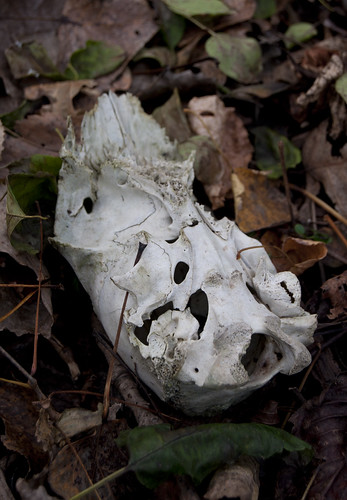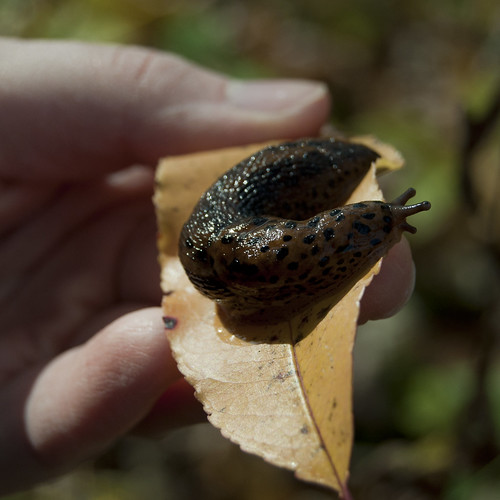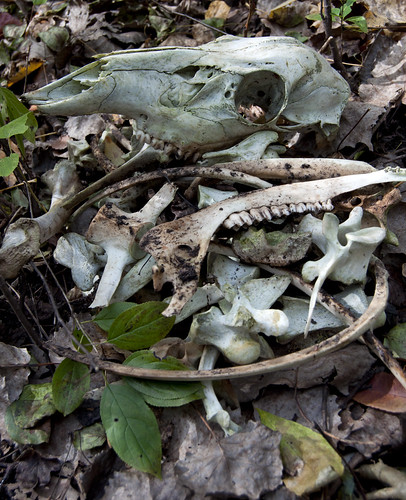The first discovery we made was a deer skull -- at least, most of one. Largely chewed away, it had been sitting in the forest for quite some time. Its size was smaller, indicating it was likely from a younger doe. Interestingly enough, there were no other bones nearby. Here is how we found it, upside-down and unmistakable in the leaf litter:

We continued on our way, and soon we found a second deer skull, also from a doe:

Many of the bones we found were heavily chewed, perhaps by animals scavenging in the winter. Rodent gnaw marks, though, were quite minimal. One animal that was using the skull was this incredibly large slug, who had been snuggled up inside the brain case:


This skull, like the first, was very clean and white, and had probably been sitting in the woods for at least a year or two. However, unlike the first, this skull was accompanied by a good deal of the skeleton. Steph and I searched through the fallen leaves for quite some time, and found about half of the vertebrae and ribs, a leg bone, and one of the jaw bones. The bone pile that we made:
Many of the bones we found were heavily chewed, perhaps by animals scavenging in the winter. Rodent gnaw marks, though, were quite minimal. One animal that was using the skull was this incredibly large slug, who had been snuggled up inside the brain case:

Steph and I returned to a nearby area at the MBG a few days later. We found a third doe skull, and like the first skull we found, this one was by itself.


In all likelihood, these three deer probably died natural deaths. They might have succumbed to the winter, or they might have been brought down by coyotes. Dixboro Road is a bit of a distance from where these bones were found, but the deer could have been injured in traffic, only to disappear into the forest to die. At this point, it's really hard to tell, though the tooth mark(s) in the second skull definitely point to coyote activity.
Though it was a bit overwhelming to find the remains of three separate deer in one (relatively) small area, it wasn't to be unexpected: deer are very prevalent in this region, especially in areas where hunting is not allowed. Their population is somewhat controlled by traffic and coyotes, but there still are plenty, and, being the large animals that they are, their remains are quite easy to locate.
Part II, which I will post in the coming days, is a completely different story, because the deaths involve the direct hand of Man -- something I have not yet explored in this project.
Though it was a bit overwhelming to find the remains of three separate deer in one (relatively) small area, it wasn't to be unexpected: deer are very prevalent in this region, especially in areas where hunting is not allowed. Their population is somewhat controlled by traffic and coyotes, but there still are plenty, and, being the large animals that they are, their remains are quite easy to locate.
Part II, which I will post in the coming days, is a completely different story, because the deaths involve the direct hand of Man -- something I have not yet explored in this project.





What kind of deer are they ? They look like the red deer we get in Scotland.
ReplyDeleteSorry for the late reply (blogspot is awful with notifications)! These three deer are all white-tailed deer. They're the only deer native to this particular area of Michigan where I live. Up north, though, there are moose and even some introduced elk herds. White-tailed deer are mid-sized deer... I think their body size is comparable to that of fallow deer.
ReplyDelete